
In recent years use of drones (unmanned lightweight aircraft controlled by an operator on the ground) has exploded. Industries and businesses have found many uses for them. Utilities and pipelines use drones as a cost effective substitute for manned inspectors. Construction companies keep tabs on jobs remotely. Commercial property owners and real estate managers use them to keep an eye on their properties, assess damage and inspect work. Farmers can watch over their crops. Entertainment venues can keep track of crowds. Law enforcement, surveyors, tax assessors, banks and property appraisers, insurance company claim adjusters, schools, the list of uses and users grows almost daily. With modern lightweight drones equipped with high resolution cameras and smart controllers that allow novice users to fly them successfully, and selling at prices that can be as low as $1,000, there is no end in sight to the potential uses of these machines.
There is also no end to potential liability and insurance issues. A standard exclusion on almost all commercial (and many personal) liability policies is for claims arising from “aircraft”. Unfortunately, “aircraft” is not a defined term in almost any commercial liability policies and many personal policies. That leaves us with dictionary definitions for what should be a well understood term; almost all of these define an aircraft as “any machine…capable of flight”, or words to that effect. Drones are machines capable of flight, so by almost any dictionary definition, drones are “aircraft”. And liability claims arising from them are excluded.
So you buy your teenager a drone for hobby use, and they somehow manage to crash it on your neighbor’s head. No coverage for the ensuing lawsuit, bad enough, but what if you are a commercial drone operator? The stakes multiply. And there’s also a privacy risk many folks are likely to overlook, from claims alleging invasion of privacy.
The FAA (Federal Aviation Administration) finally got around to publicizing regulations governing drone use, which, as you might expect, are more stringent for commercial operators; these will also continue to evolve over time. However, regulations for either commercial or recreational users currently do not mandate the purchase of liability insurance for drone operators.
Common sense, however, suggests that if you operate or contract for the commercial use of drones, you need insurance. You are not likely to find a general liability underwriter willing to delete the aircraft exclusion from their policy. There is of course a large, well established and thriving market for insurance on traditional, manned aircraft, but that’s poorly adapted to the types of claim exposures arising from drones.
Fortunately, insurance companies have begun to fill the void for liability insurance for drone operations. Coverage is readily available, relatively inexpensive, and limits up to $1 million can be found, often for premiums measured in hundreds rather than thousands of dollars; where higher limits are required or desired, there are sources that can go up to $5 million, still at reasonable cost. Some forms may also provide coverage for invasion of privacy claims, a good thing to look for. And property coverage for damage to the drone itself, or its payload, which can run to tens of thousands of dollars in value for more sophisticated operations, is also available.
Hobbyists and personal use drone operators will find it easy to find coverage. Commercial operators will be scrutinized more carefully, but should still have no difficulty finding coverage. Anyone operating drones for any commercial purpose should certainly have this coverage; anyone contracting with a commercial drone operator should insist on it.


